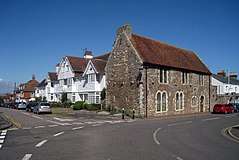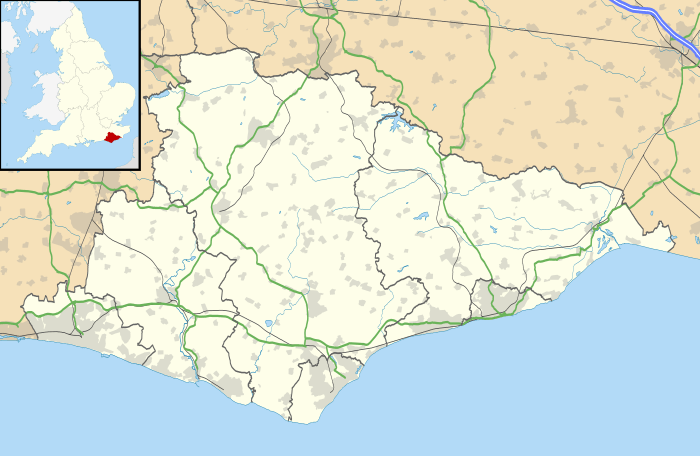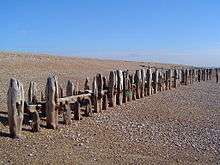Winchelsea
Winchelsea (/ˈwɪntʃəlsi/) is a small town in the non-metropolitan county of East Sussex, within the historic county of Sussex, England, located between the High Weald and the Romney Marsh, approximately 2 miles (3.2 km) south west of Rye and 7 miles (11 km) north east of Hastings. The name may be derived from the colloquial word 'qwent' that refers to the marshland behind the town and the Saxon word 'chesil' meaning shingle beach or embankment. [1]
| Winchelsea | |
|---|---|
 The Court Hall, High Street | |
 Winchelsea Location within East Sussex | |
| Population | 600 |
| OS grid reference | TQ9017 |
| • London | 54 miles (87 km) NW |
| Civil parish | |
| District | |
| Shire county | |
| Region | |
| Country | England |
| Sovereign state | United Kingdom |
| Post town | WINCHELSEA |
| Postcode district | TN36 |
| Dialling code | 01797 |
| Police | Sussex |
| Fire | East Sussex |
| Ambulance | South East Coast |
| UK Parliament | |
| Website | http://www.winchelsea.com |
The town stands on the site of a medieval town, founded in 1288, to replace an earlier town of the same name, sometimes known as Old Winchelsea, which was lost to coastal erosion. The town is part of the civil parish of Icklesham.
It is claimed by some residents that the town is in fact the smallest town in Britain, as there is a mayor and corporation in Winchelsea, but that claim is disputed by places such as Fordwich. The mayor of Winchelsea is chosen each year from amongst the members of the corporation, who are known as freemen, rather than being elected by public vote. New freemen are themselves chosen by existing members of the corporation. Thus, in its current form, the corporation is effectively a relic of Winchelsea's days as a 'rotten borough' (when Winchelsea elected two MPs but the number of voters was restricted to about a dozen, sometimes fewer).
The corporation lost its remaining civil and judicial powers in 1886 but was preserved as a charity by an Act of Parliament to maintain the membership of the Cinque Port Confederation. The mayor and corporation in Winchelsea now have a largely ceremonial role, together with responsibility for the ongoing care and maintenance of the main listed ancient monuments in the town and the Winchelsea museum.[2]
Winchelsea constitutes neither a local government district, civil parish nor charter trustees area.
Old Winchelsea
Old Winchelsea was on a massive shingle bank that protected the confluence of the estuaries of the Rivers Brede, Rother and Tillingham and provided a sheltered anchorage called the Camber. The old town was recorded as Winceleseia in 1130 and Old Wynchchelse in 1321. The Norman used to call the place Wincenesel.
History of Old Winchelsea
After the Norman Conquest, Winchelsea was of great importance in cross-Channel trade (acting in particular as an entrepôt for London) and as a naval base. In the 13th century, it became famous in the wine trade from Gascony.[3]
There may have been, in the 1260s, over 700 houses, two churches and over 50 inns and taverns thus implying a population of thousands of people at the time.[4] Prior to 1280 incursions by the sea destroyed much of the town until a massive flood completely destroyed it in 1287.
"New" Winchelsea

Today's Winchelsea was the result of the old town's population moving to the present site, when in 1281 King Edward I ordered a planned town, based on a grid, to be built. The names of the town planners are recorded as Henry le Waleys and Thomas Alard.[5] The new town inherited the title of "Antient Town" from Old Winchelsea and retained its affiliation to the Cinque Ports confederation together with Rye and the five head-ports.
Winchelsea was greatly involved in the wine trade with Guyenne and the extensive wine cellars under the town may still be visited on open days.
The town had a tidal harbour on the River Brede. It flourished until the middle of the 14th century. It then suffered French and Spanish raids during the Hundred Years' War until the 15th century and was hit by the Black Death. In 1350, the Battle of Les Espagnols sur Mer was fought nearby. In 1360 the town was sacked and burnt by a French expeditionary force, sent in an unsuccessful attempt to retrieve their King John II of France captured at the Battle of Poitiers four years earlier.[6] The town remained prosperous, although reduced in size until the 1520s. The silting of the harbour ultimately destroyed its prosperity. Camber Castle was built by Henry VIII in the early 16th century halfway between Winchelsea and Rye to guard the approach to the Camber. Much of the stone used in its construction may have been taken from the demolition of the Franciscan monastery of Greyfriars.
Winchelsea retains its medieval setting on a hill surrounded by largely empty marsh, the original layout of the planned town and the largest collection of medieval wine cellars in the country with the possible exception of Norwich and Southampton. It also retains three of the four town gates and several original buildings, including the parish church, which is dedicated to St Thomas the Martyr. Another church, St Leonard's, was later the site of a windmill, which was blown down in the Great Storm of 1987. Some of the original 13th/14th-century fortifications can still be seen at the Strand Gate and Pipewell or Ferry Gate. The scale of the original plan for New Winchelsea can be judged by the site of the "New Gate", over half a mile outside the current town.
Across the road from the churchyard stands the Court Hall, one of Winchelsea's oldest buildings, the lower floor once being the gaol. The first floor is now a museum, full of relics of the history of Winchelsea, the Corporation, and a model of the town. Nearby is the town well, dug in 1851 to save water being carried up the hill. It is thought to be 80 feet deep.[7] At the foot of Strand Hill stands the town workhouse Strand House just behind the port area of Winchelsea which runs along the river bank on the far side of the main road. This area contains the remains of several old buildings, such as the Old Malt House and Appletree Wick while Strand House itself was built around 1425 according to dendrochronology. These buildings made up the workhouse of the parish of Winchelsea being known as "The Old Poor Houses".[8] The area was a subject of archaeological investigation in 2013 which found the remains of the medieval wharf and a medieval boat next to the Bridge Inn.[9]
Winchelsea stands on the main south coast road, the A259. The Royal Military Canal built in the early 19th century as a defence-line against the highly anticipated invasion by Napoleon Bonaparte passes the eastern side of the town and connects to the river Brede.
The town lends its name to the nearby seaside village of Winchelsea Beach.
 The Parish Church of St Thomas the Martyr – aerial view
The Parish Church of St Thomas the Martyr – aerial view The Parish Church of St Thomas the Martyr – view from the east
The Parish Church of St Thomas the Martyr – view from the east The Parish Church of St Thomas the Martyr – view from the north
The Parish Church of St Thomas the Martyr – view from the north The Parish Church of St Thomas the Martyr – one of the windows with stained glass
The Parish Church of St Thomas the Martyr – one of the windows with stained glass The Strand Gate
The Strand Gate
Parish campaign
In 2006 a group of local residents requested Rother District Council to review the parishing arrangements of Icklesham, with a view to creating a separate Winchelsea Parish. The Parish of Winchelsea Action Group submitted a petition in favour from 228 electors. Other survey and polling evidence suggest the residents of Winchelsea are in favour by a majority of up to 2–1, but that the remainder of Icklesham parish was against the idea by a wide margin.[10] In the May 2007 parish council elections, the proposal for a separate parish council was the key issue. The three candidates supporting a separate parish for Winchelsea were elected by a clear majority in a record turnout of some 66% and the two opposing candidates (including a member of the Corporation and former councillor) were defeated.
Transport
Winchelsea railway station is located 0.75 miles (1.21 km) to the north in the Brede valley, on the Marshlink line between Ashford International and Hastings.
The A259 road, a major road from Hastings to Folkestone, runs around the edge of the village. Stagecoach Group run a bus service from Hastings to Rye via Winchelsea.[11]
Notable people
- Vera Atkins (1908–2000), squadron leader of SOE F Section, Col. Buckmaster's assistant at SOE, lived in Winchelsea after the second world war.
- Joseph Conrad (1857–1924) writer, lived for a time in a farmhouse on Ford Madox Ford's property
- Ford Madox Ford (1873–1939) writer, moved to Winchelsea in 1901
- Henry Irving (1838–1905) actor, lived with Eleanor Terry in a summer house in Winchelsea from 1892.[12]
- John Harris (c. 1666–1719) was rector of Winchelsea.
- Rod Hull (1935–1999), puppeteer, lived in Winchelsea.
- Spike Milligan (1918–2002) comedian, writer, musician, poet, playwright, soldier, and actor. Lived near Winchelsea. Buried in the churchyard of St Thomas', Winchelsea
- Blanche Patch (1879–1966) author and secretary to George Bernard Shaw for 30 years. One of eleven brothers and sisters, she was the daughter of the Rector of St Thomas', Winchelsea.
- Eric Slater (1896–1963) artist and printmaker, lived in Winchelsea.
- Sir Melford Stevenson PC (1902–1987) barrister and High Court Judge, lived in Winchelsea 1953–1987. His ashes are buried in the churchyard
- Ellen Terry (1847–1928) actress bought and lived in a summer house called Tower Cottage in Winchelsea beginning in 1892.[12]
See also
- List of former members of parliament
- Mayor of Winchelsea
References
- https://www.winchelsea.net
- Court Hall Museum website
- "Winchelsea website". Retrieved 1 April 2012.
- Pratt, M (1998) Winchelsea, A Port of Stranded Pride. p.3. ISBN 0-9532411-0-6
- Abercrombie, Patrick "Early Urban Planning, Vol. 8" pg. 50
- Trial by Fire – The 100 years war II by Jonathan Sumption
- Pratt, M (1998) Winchelsea, A Port of Stranded Pride. p.61. ISBN 0-9532411-0-6
- Pratt, M (2011) Winchelsea Poor Law Records 1790-1841. Sussex Records Society Vol 94. ISBN 978-0-85445-076-3
- https://sussexpast.co.uk/wp-content/uploads/2013/06/Archaeology-Round-up-to-Feb-2013.pdf
- Review of parishing arrangements
- https://bustimes.org/services/70-rye-winchelsea-bexhill-college
- Holroyd, Michael. A Strange Eventful History, Farrar Straus Giroux, 2008 ISBN 0-7011-7987-2
External links
| Wikimedia Commons has media related to Winchelsea. |
- Town Website
- Town Website
- Winchelsea Church Website
- Winchelsea at Curlie
- (in English) Audio interview with local resident about life in the town.